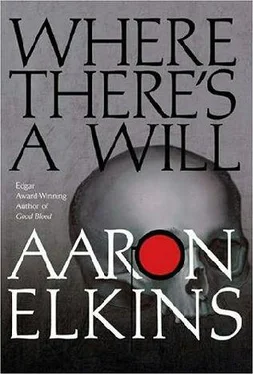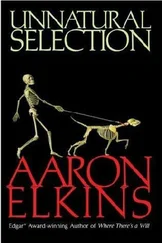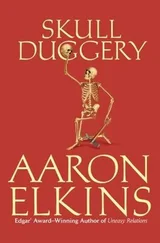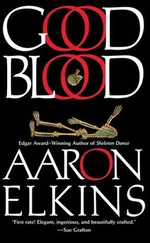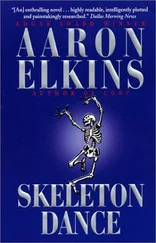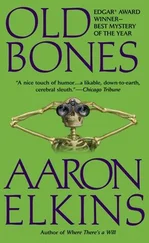Aaron Elkins - Where there's a will
Здесь есть возможность читать онлайн «Aaron Elkins - Where there's a will» весь текст электронной книги совершенно бесплатно (целиком полную версию без сокращений). В некоторых случаях можно слушать аудио, скачать через торрент в формате fb2 и присутствует краткое содержание. Жанр: Классический детектив, на английском языке. Описание произведения, (предисловие) а так же отзывы посетителей доступны на портале библиотеки ЛибКат.
- Название:Where there's a will
- Автор:
- Жанр:
- Год:неизвестен
- ISBN:нет данных
- Рейтинг книги:4 / 5. Голосов: 1
-
Избранное:Добавить в избранное
- Отзывы:
-
Ваша оценка:
- 80
- 1
- 2
- 3
- 4
- 5
Where there's a will: краткое содержание, описание и аннотация
Предлагаем к чтению аннотацию, описание, краткое содержание или предисловие (зависит от того, что написал сам автор книги «Where there's a will»). Если вы не нашли необходимую информацию о книге — напишите в комментариях, мы постараемся отыскать её.
Where there's a will — читать онлайн бесплатно полную книгу (весь текст) целиком
Ниже представлен текст книги, разбитый по страницам. Система сохранения места последней прочитанной страницы, позволяет с удобством читать онлайн бесплатно книгу «Where there's a will», без необходимости каждый раз заново искать на чём Вы остановились. Поставьте закладку, и сможете в любой момент перейти на страницу, на которой закончили чтение.
Интервал:
Закладка:
“Ah, that’s probably why it didn’t get carried off.” He took it from Lyle, gently turning it from side to side. “So this is it, then? This one bone?”
“So far. We’re gonna head back now and see what else we can find, but we wanted you to see this first. Everything is shifted and kind of crumpled up. We’ll need to use the torch some more, and we’ll see what we see. I wouldn’t get my hopes up if I was you, though.”
Except for a few dead limpet shells on the inside of the left ramus-the part that rises, behind the teeth, to form the hinge that attaches the jaw to the cranium-the mandible was as whole, as clean, and almost as white, as a specimen from a biological supply house. A right lateral incisor and one of the right premolars were missing, but they had worked their way out after death; the deep, crisp-edged sockets, with no signs of the bone-resorption that would have gone along with eventual healing, made that clear. The other fourteen teeth were still in place and only a little loose, the natural result of the loss of the soft tissue surrounding them. Both first molars and one of the remaining premolars had cheap amalgam fillings in them. The bone itself had a slightly spongy feel-a “give” to it-but so would anything else that had been soaking in a warm lagoon for ten years. It would be solid enough, once dry.
With the Shertz brothers having forgotten to bring him any of the tools he’d asked for, the table wasn’t going to do Gideon any good, so along with John, he sat down at the shady edge of the wooden platform-floor, with his bare feet in the cool, damp sand. He flicked the limpets from the bone with a fingernail and slowly turned it in his hands, running his fingers over the bumps, ridges, grooves, and hollows. After a while he gently set it upright on his knee so it was “facing” him and studied it for another minute. A single drop of sweat rolled from his forehead, down his nose, and onto the leg of his shorts.
“Well, I can tell you who it isn’t,” he said at last. “It isn’t old Magnus.”
“No, it’s female,” John said promptly.
“Right. And the age, too. This came from a young-wait a minute, how’d you know it’s female?”
John had once taken a three-day forensics course for law-enforcement personnel, at which Gideon had been the lecturer for the anthropology segment, and while he had been a willing student, it quickly became apparent that osteology was never going to be his strong suit. Thus, his quick, almost instant, determination of sex came as a surprise. The mandible in Gideon’s hand would have been a good one with which to challenge his graduate students’ abilities at sexing. The overall size and ruggedness suggested a male jaw, he said half-aloud. On the other hand, the sharpness of the anterior edges of the rami and the delicacy of the condyles were more typical of females. The symphyseal height and the gonial angle could probably have gone either way, although, without measuring instruments, it was impossible to say for certain…
As Gideon droned on, detail after detail, John nodded sagely, perspiration dripping from his chin. “True, my good fellow, very true, indeed.”
“So how’d you come up with female?”
By now John was laughing out loud. For once Gideon responded with a frown. “What? What am I missing?”
“How I came up with female,” John said, “was that I figured the odds were pretty damn high that the plane really did go down that night, and if it did, there were two people aboard-Magnus and the pilot, Claudia-and since I knew it wasn’t him, it had to be Claudia. And Claudia was a female. That’s how.”
“But how’d you know it wasn’t Magnus?”
“I knew because you just said it wasn’t, two minutes ago,” John said, breaking out laughing again, and this time Gideon went along. When he sobered, he went back to turning the mandible in his hands and running his fingers over it again.
John, whose interest in forensic anthropology did not extend to sitting around watching Gideon stare at a bone and mumble to himself, stretched, stood up, and announced that he was going off to take another swim.
“Okay, right,” said Gideon, absorbed in the examination.
However he’d arrived at it, John was correct about the mandible being Claudia Albert’s. According to the Torkelssons, she had been a big, sturdily built woman (a lummox, Dagmar had called her) of twenty-five, troubled with bulimia. And the jawbone perched on his knee had almost certainly belonged to a big, sturdily built woman of twenty-five or so, afflicted with an eating disorder, most likely bulimia. Given the context and the circumstances, there wasn’t much room for doubt as to who she was.
Despite some of the ambiguous criteria, determining the sex had been the easy part. (Determining the sex was always the easy part, given that you started with a fifty percent chance of getting it right if you simply flipped a coin.) But beyond that, the classic curvature of the chin (in anthrospeak, the convexity of the mental protuberance), as opposed to the two-cornered squareness (the bilobatedness) of the male chin, was so archetypically female that it overrode everything else, even the ruggedness and size. It was female; he was certain.
But the ruggedness and size were useful in their own right, in that they were what had told him that the mandible’s owner had probably been large and strongly built. When a mandible, or any other bone, was robust and heavily ridged and roughened by muscle attachments, it meant that the muscles that had been attached to it were strong and well-developed. And if the mandibular muscles were well-developed, it was reasonable to assume that the cranial and neck muscles were well-developed, and if that was the case, then it was only reasonable to suppose that the trunk and limb muscles were well-developed, etc., etc. The good old Law of Morphological Consistency.
So it was possible, even from a single bone-the mandible-to make some assessment of overall size and physical condition. Of course, the Law of Morphological Consistency wasn’t exactly a law, it sometimes happened that a person might have a strongly developed jaw and neck coupled with a weak thorax, or thick arms coupled with spindly legs, and when such things occurred, anthropological assessments went awry. But they didn’t happen very often, and unless something turned up to contradict it, Gideon would stick with his reading. He’d rather have had a few more bones to look at, but in this kind of work, fragmentary remains were the rule.
Ageing skeletal material was trickier than sexing it (to begin with, you had a lot more than two possibilities), but in this case it was made easier by the presence of the two partially erupted third molars-the deservedly much-maligned wisdom teeth. Inasmuch as third molars, the most variable of the human teeth as to time of eruption, generally came in (when they came in at all) somewhere between the ages of eighteen and twenty-five, and these particular ones had not quite broken all the way through, it followed that the person had probably been somewhere between those ages when she died. (Forensic anthropology, he thought, not for the first time, involved an awful lot of “probablys.”)
The eating disorder? That had been easy, the work of a single glance. The edges of the incisors were thinned and “scalloped,” almost as if they’d been gently filed. And the lingual surfaces-the sides toward the tongue-were deeply eroded and discolored, almost through the enamel. On the two central incisors, it looked as if the dentin might be showing through in spots. When you saw incisors like these, especially on a young person, the most likely cause, and the first thing that came to mind, was bulimia: the habitual, repeated vomiting that went along with it brought up stomach acid that ate the enamel away.
Читать дальшеИнтервал:
Закладка:
Похожие книги на «Where there's a will»
Представляем Вашему вниманию похожие книги на «Where there's a will» списком для выбора. Мы отобрали схожую по названию и смыслу литературу в надежде предоставить читателям больше вариантов отыскать новые, интересные, ещё непрочитанные произведения.
Обсуждение, отзывы о книге «Where there's a will» и просто собственные мнения читателей. Оставьте ваши комментарии, напишите, что Вы думаете о произведении, его смысле или главных героях. Укажите что конкретно понравилось, а что нет, и почему Вы так считаете.
